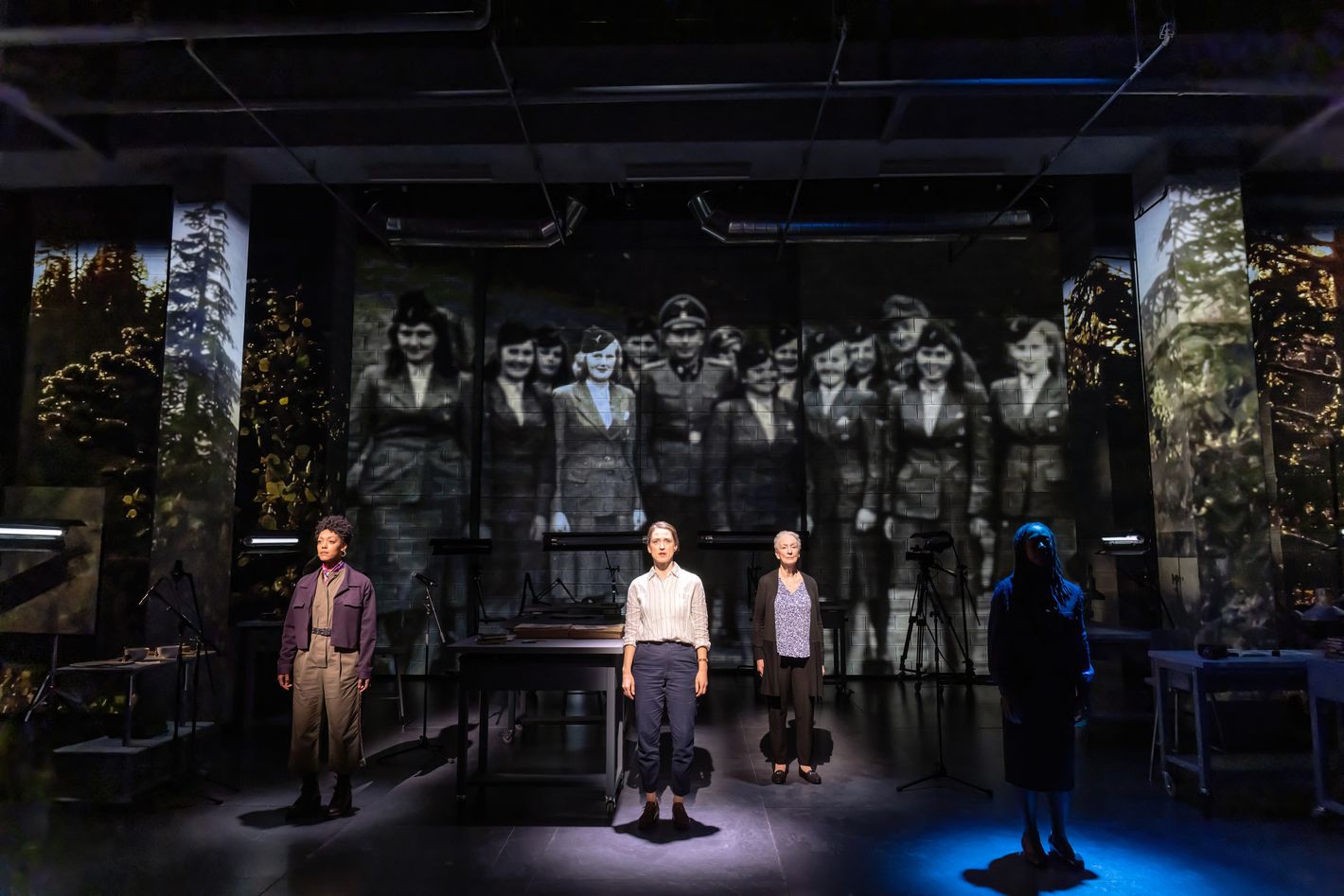
Moisés Kaufman first saw the photographs that prompted the creation of Here There Are Blueberries in 2007. He first contacted Rebecca Erbelding, the archivist and historian who brought the photos to light, in 2010. The play — a documentary-style piece grappling with the images, which give a Nazi’s-eye view of Auschwitz — was written by Kaufman and Amanda Gronich and developed by Kaufman’s Tectonic Theater Project over more than a decade, building on research, interviews, and the company’s signature devising process of “moment work.” After premiering at La Jolla in 2022, it went to D.C.’s Shakespeare Theatre Company, just a short walk across the National Mall from the Holocaust Memorial Museum, where Erbelding works and where the photos live in the archives; more recently, during its previews at New York Theatre Workshop, the play became a Pulitzer finalist. There’s nothing hasty about Here There Are Blueberries — it has been built, piece by deliberately laid piece, over years, and its run at NYTW comes augmented with a whole series of talk-backs and scrupulously planned postshow discussions.
And yet, at least in my experience of the show, there’s the hovering sensation of something not being addressed. Here we are, at the theater where the playwright Victor I. Cazares launched a personal strike declaring that they would stop taking their HIV meds until their onetime “artistic home” called for a ceasefire in Gaza (NYTW never did; artistic director Patricia McGregor responded with this letter). And here we are at the end of a theatrical season that has felt particularly crowded — even by the standards of the form, which is always pretty present in New York — with Holocaust plays. A show both can and cannot help the moment it lands in. Development processes take months, or, as with Blueberries, years. But even the most slapdash productions don’t go up in the same world in which they were conceived. Every play, and every team of artists, owes something to itself: Are we telling the story we set out to tell? And, to some degree, to the context in which it finds itself: What does this story, whatever our original intentions, mean now? By avoiding any clear allusion to Gaza, not even a nod in its copious program materials, Here There Are Blueberries provokes a nagging feeling of double vision. Through one eye, you’re watching an earnest, solidly crafted show in which a group of fine actors dissects a fascinating and appalling historical artifact. Through the other, you’re watching a production, a theater, and a theater world that, on the whole, still somehow can’t bring itself to make its parallels explicit — to say out loud, That was an atrocity and so is this. A genocide happened then, and one is happening now. Cease fire.
Angering theatergoers has to be okay, has to be something we stop fearing. Comparison is beyond fraught when it comes to the Holocaust, but the truth is that comparison — which, counter to some arguments, is not necessarily diminishment — is already implicit in every piece of historical theater. We are presented with lenses through which to witness our own moment. Events, no matter how monumental or horrific, become points of reflection, whether or not we are willing to reflect.
What’s striking is that Here There Are Blueberries knows as much. Its protagonist — the rich-voiced Elizabeth Stahlmann’s thoughtful evocation of Erbelding — repeatedly pauses to ask herself, “What would I have done?” or “Who are we in the story?” Erbelding is guiding us through the Höcker Album, a collection of photographs that a retired U.S. lieutenant colonel brought to her attention in late 2006. Taken by Karl Höcker, adjutant to the Nazi commandant Richard Baer, the photos depict day-to-day life at Auschwitz as experienced by the camp’s officers and communications staff (women known as Helferinnen, who worked the switchboards). There are casual lunches and staff outings, people relaxing in lawn chairs, playing the accordion, laughing in the rain, eating blueberries. There isn’t a single prisoner in the 116 images. Like Jonathan Glazer’s The Zone of Interest, the Höcker Album horrifies through its sunlit mundanity, its blithe — and, in this case, indisputably factual — representation of mass murderers and their accomplices not as monsters but as smiling, pie-faced family men and rosy-cheeked young women. “A bank clerk, a sweet-maker, an accountant,” says the curator Paul Salmons (Scott Barrow), listing the prewar professions of Höcker (also embodied by Barrow); his boss, Baer; and Josef Kramer, who ran the extermination center at Birkenau. In the face of such a document, the credo “Never again” becomes not simply a call to resist authoritarianism, or even to be awake to the continued scourge of antisemitism, but a warning to ourselves about ourselves: See how easy it is to live as if you and those closest to you are the only actual human beings in the world?
Zadie Smith wrote recently, and with much ensuing ire, about “that fantastical, linguistical, conceptual, unreal place” where public intellectuals, and surely plenty of private citizens, feel pressured to plant a “rhetorical flag” regarding Palestine and Israel. In my own way, so did I. I sympathize with Smith’s addiction to humanism — in the brutal, reductive currents of the world, I too find myself clinging to complexity and nuance as a life raft. But why should that raft become a shield or a mask? Why should a belief that people are people, that history is a thousand-thread knot, and that words are highly imperfect tools stop us from saying and doing all we can in the service of what’s right? As it stands, “all we can” too often feels like next to nothing, yet still we hesitate. Is an individual play, artist, or institution responsible for making clear public statements beyond the broader template of values expressed in their work? I don’t know the answer, or whether it’s an answer that is always the same, one moment to the next — I suspect not. I suspect that, sometimes, invisible thresholds are crossed, and beyond these shifting lines, not speaking becomes in itself a kind of speech.
This is why Here There Are Blueberries is one play in an artistic vacuum and another in, well, the world. Part of the problem is that, in plays that take us where Kaufman and Gronich’s does, we’re dealing with content that both is and is not metaphor. One viewer will see the Höcker photos — and those from the Auschwitz Album, which stand in sickening contrast to Höcker’s — and will hear Holocaust historian Stefan Hördler (Nemuna Ceesay) talk about how “for the Nazis, the whole process of killing people [was] about dividing responsibilities”; or she will listen to Stahlmann, speaking in the person of Holocaust survivor Lili Jacob about being torn from her family, all of whom were murdered, and she — this viewer — will think, We are doing it again. Destroying families, killing children, and spreading the complicity as thin as we can to decrease the sting. Another viewer will see and hear all the same images and words and will think, This event stands alone and always will, and this is exactly why Israel needs to exist and to defend itself.
The show makes space for both these audience members and those in between, and perhaps this is precisely what it wants to do; some may even argue that such multi-partisan inclusivity is one of theater’s key jobs. But I am hesitant about the number of productions I have seen this year alone that, in their retreading of our shared history, seem to be offering their audiences not so much an opportunity for hard reflection and possible change of mind as for confirmation of the mind-set they walked in with. When, in his much-misunderstood Oscars speech, Jonathan Glazer addressed the “dehumanization” of both “the victims of October 7 in Israel” and of “the ongoing attack in Gaza,” he expressed the pain of having “Jewishness and the Holocaust [be] hijacked by an occupation.” What’s happening now is that with each new production that returns us to these subjects and these places without some kind of defiance of Zadie Smith–ian remove, this hijacking is being allowed to continue. Though Kaufman and Gronich still have their responsibility to their own process and story in its more contained, theatrical sense, there must exist more possibilities than persisting in keeping that story’s current resonances so pointedly limited. It’s not about radical rewrites — a statement in the program, a gesture from the stage, a coda of some kind, one postshow discussion that mentions Gaza? Surely, this is a different play than the one that opened at La Jolla in 2022; surely, the behind-the-scenes conversations have been frequent, long, and difficult. Why not bring more of that difference and difficulty to the stage?
It’s a shame not just in this broader sense but in a more finely focused one that Here There Are Blueberries is haunted by an aura of contextual diffidence because so much that’s compelling is happening in the production. Derek McLane’s set design riffs on the layout and equipment of an archival-research lab, and its fluid interaction with David Bengali’s projections creates an eerily elegant backdrop for the Höcker Album’s procession of calm, awful images. Stahlmann, Ceesay, Barrow, and the rest of the ensemble (including the wonderful Kathleen Chalfant as Erbelding’s supervisor, Judy Cohen) never overgild or sentimentalize their many parts, and in a few striking moments, they bring the photos to life with jolts of terrible energy. “Rain from a clear sky,” reads the translation of one picture’s caption: We see a series of photos of the Helferinnen posing with Höcker, their grinning boss; thunder claps, and then the candids show the group scattering in a surprise summer downpour. Beneath the looming projected images, the women in the cast stand in a line, giggling and shrieking with delight.
“Feigling,” says Heinz Baumkötter (one of the Nazi officers in the photos, played with square-shouldered inscrutability by Ceesay). “Maybe I was … Feigling. A coward. Maybe I was a coward at times, and for this reason, I didn’t do what I should’ve done.” It’s something Baumkötter’s grandson, Tilman Taube (played by Jonathan Raviv), remembers him saying, and of all the words spoken in Here There Are Blueberries by figures portrayed in the Höcker Album, these feel the most honest, the least self-protective — the easiest, and most frighteningly so, to locate within one’s own soul. They raise the same question that lurks in the silent gap where this and so many projects and institutions, whether consciously or not, draw the line of their current political engagement: What are we so afraid of?
Here There Are Blueberries is at New York Theatre Workshop through June 16.
Sara Holdren , 2024-05-14 20:54:56
Source link


